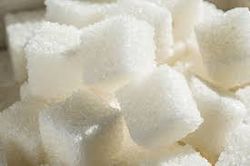Sugar
(drug) | |
|---|---|
 | |
| Sugar is rarely considered a drug, but it is classified here as such due to its addictive nature and negative impact on health. |
Sugar is a label given to a range of white crystalline solids. They are naturally occurring, high in calories, and sweet tasting.
Contents
Occurrence in nature
Sugar is relatively rare in natural foods, but as a cheap and taste giving additive is has become almost ubiquitous in modern processed food.
Health effects
Sugar consumption has been long been suspected to be correlated with poor health outcomes, including obesity and diabetes. Research results to this effect have existed since at least the 1970s. However (as with Glyphosate) this information was however not widely disseminated, due to commercial pressure (in this case, from the sugar lobby).[1]
Exposure
Since the 1970s, the effects of chronic high consumption of sugar have gradually been recognised - in particular its correlation with obesity.[citation needed]
21st Century
In 2019, Public Health England claimed that the average 10 year old in the UK had consumed as much sugar as was recommended for an 18 year old.[2]
Related Quotations
| Page | Quote | Author | Date |
|---|---|---|---|
| Regulatory capture | “The Food and Drug Administration. The FDA was charged with overseeing the manufacture of cereal, along with all other processed foods except meat and poultry, which were controlled by the Department of Agriculture. It steadfastly refused, however, to see sugar as a threat to the public's health. Moreover, it repeatedly declined to require food manufacturers to disclose, on their packaging, exactly how much sugar they were adding to their products... Where Washington had failed to act, two men working on behalf of the public took the Big Three on themselves. One was an enterprising dentist, Ira Shannon, with the Veterans Administration Hospital in Houston, who [in 1975], alarmed by the exploding rates of tooth decay he’d seen in his young patients, decided that he’d had enough. (By one estimate, there were at any given moment one billion unfilled cavities in American mouths.) So the dentist took a trip to his local supermarkets, brought seventy-eight brands of cereal back to his lab, and proceeded to measure the sugar content of each with damning precision. A third of the brands had sugar levels between 10 percent and 25 percent. Another third ranged up to an alarming 50%, and eleven climbed even higher still — with one cereal, Super Orange Crisps, packing a sugar load of 70.8%. When each cereal brand was cross-referenced with TV advertising records, the sweetest brands were found to be the ones most heavily marketed to kids during Saturday morning cartoons.” | Michael Moss | 2013 |
| John Yudkin | “If only a small fraction of what we know about the effects of sugar were to be revealed in relation to any other material used as a food additive, that material would promptly be banned.” | John Yudkin | 1972 |